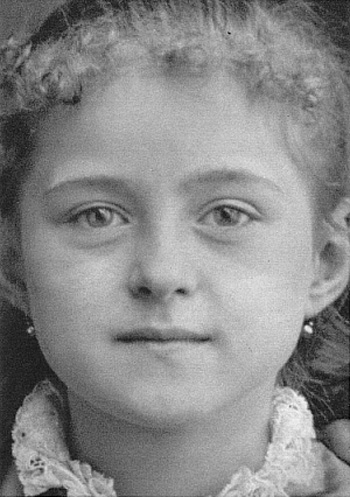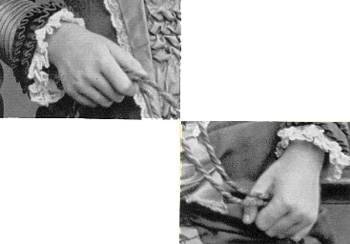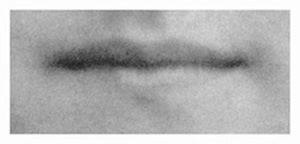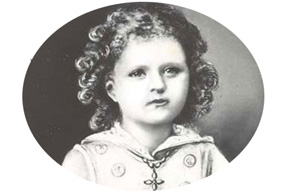Catholic Virtues
 |
 |
 |
 |
 |
 |
 |
The Personality of St. Therese of Lisieux - I
St .Therese’s Photograph: First Impressions
We have been discussing the thirst for souls and someone might naturally ask: "What is the proper and ordered attitude a person should have to discern a soul?”
For this very important question to be clear, I thought nothing would be better than to examine this magnificent photograph of St. Therese of the Child Jesus at age 8, holding a jump rope. It really is magnificent; only the third dimension is missing to say that it is alive.
 To comment on this soul, I would ask you to make a special effort not to pay so much attention to what I will say, but rather to yourselves. It is an unusual conference in which I will try to explain not what I think of St. Therese, but what some of you are thinking about her. That is to say, what impression seeing this photograph produces in some of you.
To comment on this soul, I would ask you to make a special effort not to pay so much attention to what I will say, but rather to yourselves. It is an unusual conference in which I will try to explain not what I think of St. Therese, but what some of you are thinking about her. That is to say, what impression seeing this photograph produces in some of you.
Naturally, I will improvise. When things like this are over-prepared, they lose their life.
First impression
Upon seeing her, the first impression is this: What an amazing child! She is still a little girl, full of life, fresh, lively and with that kind of extroversion proper to a girl in her childhood. In her you see the beauty of a child's soul, the delicacy and fragility in the shining integrity of the feminine nature. How skillful the photographer was in capturing this young girl! This is the first impression.
Idea of purity
After this impression comes another. At the same time the person recognizes how this girl is embellished with this innocence, vivacity and shining authenticity, he perceives an idea of purity associated with her. And he feels this in more or less everything. Purity is present, above all, one notes it in a good spontaneity, in the authentic sense of this word.
She is a girl who hides nothing, who does not have the habit of hiding anything and who knows perfectly well that she has nothing to hide. In her there is no fraud or dissimulation. About her we can say what Our Lord said about Nathanael: "Behold a true Israelite, in whom there is no guile." (Jn 1:47)
Here is a true, pure girl, daughter of a Catholic family, who has in herself all the purity and candor of a Catholic family life, all that virginal delicacy that the life of a Catholic family communicates in a special way to a girl; and all this without any guile. She has this purity and candor completely, and is not in the habit of sinning.
Baptismal Innocence
One looks at her and he sees that she is authentic. She will speak and walk with a naturalness, an élan and a spontaneity that has much of the French lightness and grace, with a baptismal innocence that was never broken. This soul was not disfigured by sin.
 She has a type of purity that is not just modesty. I am not referring to that kind of comment: "Yes, see how her arms are covered and the skirt goes below the knees." I am referring to a purity of gaze.
She has a type of purity that is not just modesty. I am not referring to that kind of comment: "Yes, see how her arms are covered and the skirt goes below the knees." I am referring to a purity of gaze.
This purity of gaze, this purity of soul, is not just the purity of chastity, it is the purity of one who has never sinned. It is the state of baptismal innocence with all its perfume, with a kind of candor that is for the soul more or less like the life for the body – a type of life in the body you cannot localize: It is here, there, in everything, in the living body. Here also baptismal innocence is in everything, it is everywhere.
We are doing an itinerary of impressions: The first impression was of a girl; in the second impression the idea of purity entered; from the idea of purity we rise to the idea of virginal purity, which is already such a high thing. From there we move on to something greater than this, which is baptismal innocence, the state of grace never broken in a soul. Here, also, a French word could be applied which I do not know how to translate: the state of grace never flétri (the mark of a hot iron imprinted on a criminal's skin – analogically, the mark of sin left on a guilty soul) in a soul.
A reflective internal order
Now I will begin an analysis by the comparative process. So far I have not used any comparison because it was unnecessary. Now, I ask: What else can we note about this child? She is such a lively girl, but there is nothing noisy or unreflective in her.
 If she were to start to jump rope, she would not jump in a ridiculous, roughhousing, unthinking way. She would suddenly run off, but not, for example, in a silly way.
If she were to start to jump rope, she would not jump in a ridiculous, roughhousing, unthinking way. She would suddenly run off, but not, for example, in a silly way.
Everyone perceives that her spontaneity is governed by a certain rule, whereby she never does what she should not do. Her spirit is ordered; she has a way of thinking and reflecting on things. It is the reflection of a child, the thinking of a child, the way of ordering things of a child, instinctive and subconscious, but real, where in everything she acts like a child, a true child, not some little know-it-all, a little woman mixed with a little philosopher.
She is the opposite of this. She is completely natural, but extremely well-ordered, and has in herself a great internal order. You cannot imagine this girl doing anything foolish, it is understood that she would not. Through this we understand the order that exists within her.
The smile
Entering a more delicate part of the analysis, we perceive that her mouth is straight, with the lips thin and very firm. It is a firmness in which not a drop of bitterness exists. On the contrary, there is a certain indefinable smile. Everyone talks about the smile of Mona Lisa, but this is what a smile is! She is not really smiling, although there is an indefinable smile on her lips. There is something about her that smiles, without one being able to properly say that she is smiling.
 One has the impression that the photographer told her to smile, and, in order not to disregard him, she sketched something vaguely like a smile. There is something of smile that extends to her whole face: a slight smile in the eyes, a bit on the lips, in the general affability of her person. She assumes a very affable and welcoming position, a position of goodwill towards everyone.
One has the impression that the photographer told her to smile, and, in order not to disregard him, she sketched something vaguely like a smile. There is something of smile that extends to her whole face: a slight smile in the eyes, a bit on the lips, in the general affability of her person. She assumes a very affable and welcoming position, a position of goodwill towards everyone.
However, it is a smiling attitude that at the same time indicates strength of soul and character, in the proper sense of the word. It is the opposite of these Sulpician white-heresy (sentimental) pictures of St. Therese where she is throwing roses and smiling in a completely different way. She has nothing of that kind of smile, the smile of a china doll. Rather, here is a smile behind which there is thinking. It is the type of thinking to which one should properly aspire.
Continued


For this very important question to be clear, I thought nothing would be better than to examine this magnificent photograph of St. Therese of the Child Jesus at age 8, holding a jump rope. It really is magnificent; only the third dimension is missing to say that it is alive.

St. Therese, age 8
Naturally, I will improvise. When things like this are over-prepared, they lose their life.
First impression
Upon seeing her, the first impression is this: What an amazing child! She is still a little girl, full of life, fresh, lively and with that kind of extroversion proper to a girl in her childhood. In her you see the beauty of a child's soul, the delicacy and fragility in the shining integrity of the feminine nature. How skillful the photographer was in capturing this young girl! This is the first impression.
Idea of purity
After this impression comes another. At the same time the person recognizes how this girl is embellished with this innocence, vivacity and shining authenticity, he perceives an idea of purity associated with her. And he feels this in more or less everything. Purity is present, above all, one notes it in a good spontaneity, in the authentic sense of this word.
She is a girl who hides nothing, who does not have the habit of hiding anything and who knows perfectly well that she has nothing to hide. In her there is no fraud or dissimulation. About her we can say what Our Lord said about Nathanael: "Behold a true Israelite, in whom there is no guile." (Jn 1:47)
Here is a true, pure girl, daughter of a Catholic family, who has in herself all the purity and candor of a Catholic family life, all that virginal delicacy that the life of a Catholic family communicates in a special way to a girl; and all this without any guile. She has this purity and candor completely, and is not in the habit of sinning.
Baptismal Innocence
One looks at her and he sees that she is authentic. She will speak and walk with a naturalness, an élan and a spontaneity that has much of the French lightness and grace, with a baptismal innocence that was never broken. This soul was not disfigured by sin.

This purity of gaze, this purity of soul, is not just the purity of chastity, it is the purity of one who has never sinned. It is the state of baptismal innocence with all its perfume, with a kind of candor that is for the soul more or less like the life for the body – a type of life in the body you cannot localize: It is here, there, in everything, in the living body. Here also baptismal innocence is in everything, it is everywhere.
We are doing an itinerary of impressions: The first impression was of a girl; in the second impression the idea of purity entered; from the idea of purity we rise to the idea of virginal purity, which is already such a high thing. From there we move on to something greater than this, which is baptismal innocence, the state of grace never broken in a soul. Here, also, a French word could be applied which I do not know how to translate: the state of grace never flétri (the mark of a hot iron imprinted on a criminal's skin – analogically, the mark of sin left on a guilty soul) in a soul.
A reflective internal order
Now I will begin an analysis by the comparative process. So far I have not used any comparison because it was unnecessary. Now, I ask: What else can we note about this child? She is such a lively girl, but there is nothing noisy or unreflective in her.

Everyone perceives that her spontaneity is governed by a certain rule, whereby she never does what she should not do. Her spirit is ordered; she has a way of thinking and reflecting on things. It is the reflection of a child, the thinking of a child, the way of ordering things of a child, instinctive and subconscious, but real, where in everything she acts like a child, a true child, not some little know-it-all, a little woman mixed with a little philosopher.
She is the opposite of this. She is completely natural, but extremely well-ordered, and has in herself a great internal order. You cannot imagine this girl doing anything foolish, it is understood that she would not. Through this we understand the order that exists within her.
The smile
Entering a more delicate part of the analysis, we perceive that her mouth is straight, with the lips thin and very firm. It is a firmness in which not a drop of bitterness exists. On the contrary, there is a certain indefinable smile. Everyone talks about the smile of Mona Lisa, but this is what a smile is! She is not really smiling, although there is an indefinable smile on her lips. There is something about her that smiles, without one being able to properly say that she is smiling.

However, it is a smiling attitude that at the same time indicates strength of soul and character, in the proper sense of the word. It is the opposite of these Sulpician white-heresy (sentimental) pictures of St. Therese where she is throwing roses and smiling in a completely different way. She has nothing of that kind of smile, the smile of a china doll. Rather, here is a smile behind which there is thinking. It is the type of thinking to which one should properly aspire.
Continued

St Therese, age 3

Posted May 15, 2019














